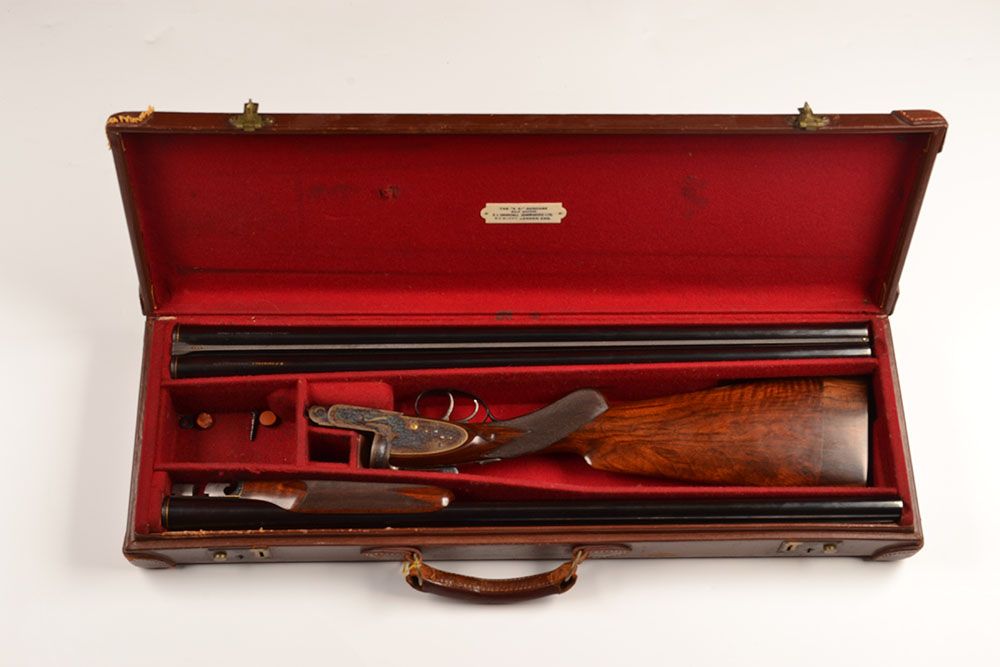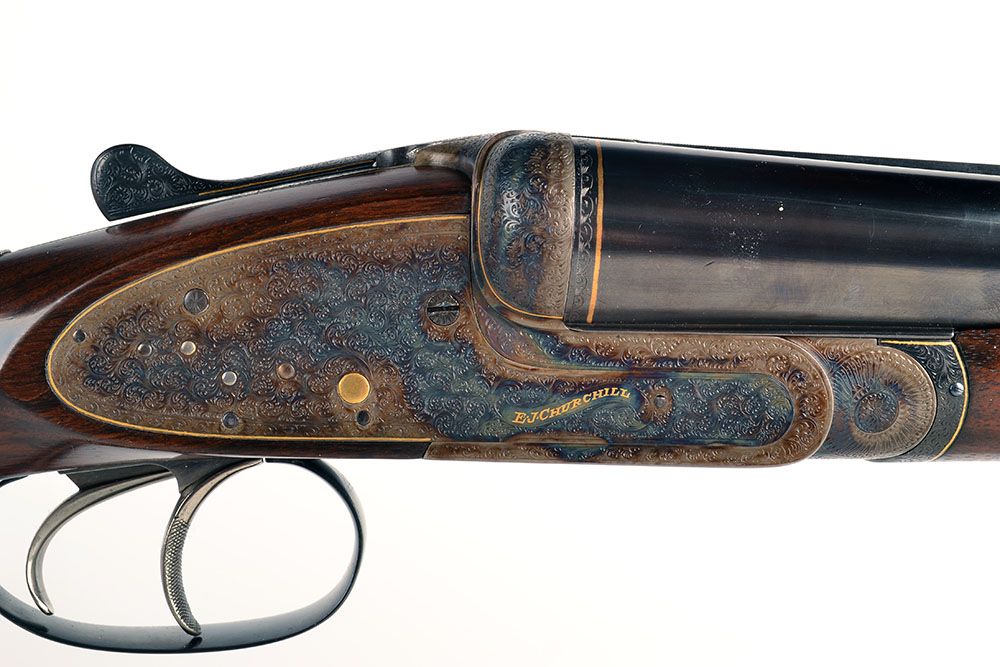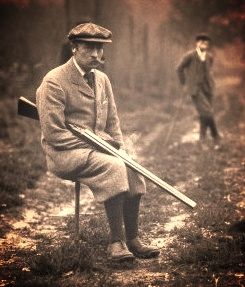|
S |
M |
T |
W |
T |
F |
S |
|
|
|
|
1
|
2
|
3
|
4
|
|
5
|
6
|
7
|
8
|
9
|
10
|
11
|
|
12
|
13
|
14
|
15
|
16
|
17
|
18
|
|
19
|
20
|
21
|
22
|
23
|
24
|
25
|
|
26
|
27
|
28
|
29
|
30
|
31
|
|
|
|
1 members (Tim Wolf),
508
guests, and
6
robots. |
|
Key:
Admin,
Global Mod,
Mod
|
|
|
Forums10
Topics38,501
Posts545,497
Members14,414
| |
Most Online1,344
Apr 29th, 2024
|
|
|
|
Joined: Nov 2006
Posts: 534
Sidelock
|

Sidelock
Joined: Nov 2006
Posts: 534 |
I just received one from Harry that came through Fedex.
WC-
|
|
|
|
|
Joined: Dec 2001
Posts: 3,577 Likes: 88
Sidelock
|

Sidelock
Joined: Dec 2001
Posts: 3,577 Likes: 88 |
|
|
|
|
|
Joined: Mar 2013
Posts: 84
Sidelock
|

Sidelock
Joined: Mar 2013
Posts: 84 |
"dearmer," I recently purchased at Holt's March auction a cased E. J. Churchill sidelock pigeon gun, 2-barrel set. Because the gun is pre-1899, having been completed in 1898, it is an unregulated "antique firearm" in the United States. This is the first 'antique' gun by the maker seen by me; although, it is likely there are other examples extant. That it is a sidelock by Churchill is particularly gratifying. The buttstock and extension remarked will soon be sent to some fine craftsman to appropriately refinish and blend the joined pieces (Mark Larsen, etc.).   Harry Gordon (email: harry@hgss-global.co.uk) and Mark Johnson of HGSS-Global, recommended by Holt's Auctioneers, are shipping the gun to me, via the local international airport. They are very much in business. Their invoice was $508.00 USD. This export is being effected on their Open General Export License. The oddment is that this antique firearm is being exported from England and imported into the United States on my Declaration and my completed End-User Undertaking (which goes to U.K. Customs), which indicate that the gun was completed in 1898 and that neither the gun nor its extra barrel set (circa 1939) requires a U.S. import license (or ATF Form 6), and as such is an unregulated "antique firearm" (equally not a "firearm," as that legal term is defined) in the U.S., as that legal term is defined in applicable federal statutes and regulations. A second needed Declaration from Holt's has also been secured, together with their bill-of-sale, which provides another proof of age by its indicating the date of manufacture. Their Declaration combines with my own. All details match. U.S. Customs and Border Protection requires proof of age as an antique (which also avoids excise tax) and a bill of sale, which helpfully also indicates the date of manufacture, and all being needed to facilitate the collection of my imported antique firearm upon arrival at the airport. All paperwork, with the exception of that drafted by me from their provided paradigms, has been completed by HGSS. The much anticipated shipment is on the cusp of being finally shipped as I write this. When arrived and personally collected, I will report back. At all events, I would highly recommend Harry and Mark to anyone exporting a firearm from the U.K. into the United States; their 30-year experience in the field is telling and virtually recommends itself. Regards, Edwardian
|
|
|
|
|
Joined: Aug 2011
Posts: 704 Likes: 1
Sidelock
|

Sidelock
Joined: Aug 2011
Posts: 704 Likes: 1 |
Edwardian, that is a gorgeous Churchill - congrats!
|
|
|
|
|
Joined: Mar 2013
Posts: 84
Sidelock
|

Sidelock
Joined: Mar 2013
Posts: 84 |
Thank you. Yester-day I personally collected the above-mentioned cased E. J. Churchill gun bought from Holt's Auctioneers and imported into the U.S., after being notified by the carrier that my shipment had arrived at the local international airport. Besides the paperwork previously completed and included with the shipment already in my possession, the carrier provided me a copy of the final version of the carrier's "Air Waybill" and their "Transportation Entry and Transit Air Cargo Manifest" via email attachment.
These latest documents too were taken to the airport and presented to U.S. Customs and Border Protection. The receiving officer looked cursorily at my paperwork, went to his assigned computer and stamped a general release (which he also executed and dated) on the Air Waybill, and used another device to perforate that and the other documents with identifying numbers for the shipment. Within a matter of 15-minutes, I was back in my vehicle and driving to the opposite side of the airport grounds where the carrier's offices and warehouses are located. Once there, and after re-presenting the stamped and perforated documents to staff, which were copied by them and returned to me, it needed another 10-minutes before the shipment was hand-trucked to my vehicle and placed into its trunk.
The collection of my shipment required some 30-minutes to accomplish. So, if the gun you are importing is an "antique firearm," as that legal term is defined in applicable statutes and regulations, it is indeed possible to personally make the arrangements with the appropriately licensed exporter and do the collecting of the shipment yourself. Other than the final shipping documents earlier described, all that is otherwise needed for eventual presentation to U.S. Customs and Border Protection for their approval of the importation of your firearm as an "antique firearm" is a proof of age certification (this proof also excuses you from paying excise tax on the antique import) document and a bill of sale. If the bill of sale also indicates the date of manufacture as pre-1899, so much the better. The agency's official website provides this very same information with respect to "antique firearms." (i.e. generally: "... any firearm manufactured in or before 1898.")
One of the great things about collecting antique firearms (and for me, especially those conveniently bought in the U.K.) is that Congress has historically never evinced an intention to regulate antique firearms, which means they are unregulated here and also when imported. Therefore, wherever a statute or regulation addresses "firearm," and whether that legal term is used as an adjective or a noun in a U.S. federal statute or regulation, the legal term "antique firearm" is invariably excluded (Hint: Look for the statute's or regulation's paragraphs addressing 'definition of terms' or 'definitions' used in the particular title and / or section referenced or cited.) from the statutory or regulatory legal definition for "firearm." The legal term "firearm" does not incorporate the legal term "antique firearm." And if the latter legal term is excluded by legal definition, that excluded class of firearm does not fall under the regulatory authority of the federal statute or regulation addressed.
The separate terms "firearm" and "antique firearm" are not generic terms, they are instead specific legal terms, as legally defined in federal law and regulations, and must be read from that perspective alone, in order for the statute or regulation referenced to be understood and comprehended correctly. It is that difference that informs why it is that ATF has neither legal regulatory authority over antique firearms in this country nor when the same are imported into the United States. Unfortunately, and I have run afoul of it at times, a lot of misinformation and astounding ignorance has been disseminated on this subject. The better approach, in my opinion, should you want to engage in the importation of your antique item, is to conduct personal research and come to understand what and if you can do something, and why you can or cannot do so, and then act accordingly and informed.
I wish all those desirous of importing antique firearms into the United States the very best of luck and a good experience.
Regards,
Edwardian

|
|
|
|
|
Joined: Nov 2006
Posts: 534
Sidelock
|

Sidelock
Joined: Nov 2006
Posts: 534 |
My gun was indeed an antique.
That is the third time I do this.
This time it became a complete nightmare.
Because the value was over $2500, I could not do in "informal entry" and had to do a "formal entry". This is not doable at the airport and the procedure is horrible for you or I. ( I was warned at the main customs office in SF, that the procedure "could last all day" and it did not look that they were willing to go through it at all.)
After being given a major run-around, it turns out that I had to use a US customs certified and bonded broker to do it.
This cost me another $500 or so and I had to find somebody in a big hurry.
Fortunately, the Fedex employee was extremely helpful and pointed me in the right direction.
Overall, I had to go to the airport 3 times before I got things figured out.
The conclusion is: do not ship anything with a value over $2500 without a broker involved...
Best regards,
WC-
Last edited by WildCattle; 04/14/16 03:41 PM.
|
|
|
|
|
Joined: Aug 2011
Posts: 704 Likes: 1
Sidelock
|

Sidelock
Joined: Aug 2011
Posts: 704 Likes: 1 |
Customs has always required me to hire a Customs Broker every time I have imported from the UK. Nothing I have imported was pre 1898 either.....
|
|
|
|
|
Joined: Dec 2001
Posts: 3,577 Likes: 88
Sidelock
|

Sidelock
Joined: Dec 2001
Posts: 3,577 Likes: 88 |
If it's not antique, (pre 1898), it's considered a firearm and must be imported with a broker.
|
|
|
|
|
Joined: Mar 2013
Posts: 84
Sidelock
|

Sidelock
Joined: Mar 2013
Posts: 84 |
"Wildcattle," et al., my recently imported antique firearm was valued for insurance purposes by several factors higher than the $2,500 figure you cite, but this is really beside the point because the monetary 'value' of an 'antique' anything has nothing whatever to do with formal or informal entry, etc. This inapplicable jargon serves to alert one to the high probability that someone or several someones erred. Provably antique anything imported, to include an "antique firearm" (i.e. "... any firearm manufactured in or before 1898" [emphasis added], or in other words is of pre-1899 manufacture), of course, is not taxed when their antique status can be demonstrated to U.S. Customs and Border Protection. This is done by providing them a proof of age verification and your bill of sale, which should also indicate, in my opinion, the date of manufacture.
In pertinent part, the U.S. Customs and Border Protection website states, "If the firearm is at least 100 years or more and you can provide proof of age, the firearm is eligible for duty-free treatment under the antique provision of the Harmonized Tariff Schedule." So the monetary value of your shipment was not a valid consideration, which again leads me to believe something else was involved. That something else must have been an error on someone's part and it was that which became the causal factor for the unwanted difficulties you describe.
Moreover, I am at a loss to understand what happened to your shipment other than to surmise that the exporter did not fully know what they were about and / or something was amiss with their paperwork or lack thereof, or perhaps the U.S. Customs agent was not informed on the subject of the importation of antique firearms. It is certainly likely, too, the customs broker also was not ably informed on the subject, which is more common than one would think. And that it was one or a combination of those elements that caused the supposed need for a customs broker to engage, which is an unneeded third party otherwise, in order to unravel the ensuing mess thereby created. Although, I would put my money on the exporter being the likeliest candidate at fault.
For example, in the recent past, I personally experienced an unnecessary two-week delay in the international shipment of a valuable antique firearm from England because the exporter (with decades of experience shipping firearms internationally) asserted, quite wrongly, that an extra set of post-1898 gun barrels, of a 2-barrel set, would require them to ship the antique firearm's stocked action body and original barrel set to me separately, and that I would need to file a Form 6 with the ATF with respect to the newer barrel set and receive ATF's blessing before they would ship that barrel set to me at additional cost. The exporter stubbornly maintained this baseless and untenable position.
When I disagreed vehemently with their inapt assessment, they answered by telephoning ATF in West Virginia from overseas in an attempt to prove their point, and not surprisingly were reportedly told by equally uninformed ATF staff that, yes, I needed to file their Form 6 for importation of the newer barrels and, by the way, we will require another to be filed for the antique firearm being imported as well. This conduct and interference was ridiculous at best because, as was earlier shown herein, ATF has absolutely no legal authority over any "antique firearm," whether the same is resident in the United States or being imported into it. However, doing something illegal has never prevented ATF from doing anything known to be, as we should all know, and that if you use 'incompetent' and 'bureaucrat' in the same sentence it is most often a redundancy. I see this amply demonstrated in federal courtrooms across our State on a weekly basis.
Yet this particular exporter held its ground; that is, until I provided them a written legal opinion on the subject, which irrefutably showed their position to be a perfect nonsense. So, we all have difficulties with incompetence or ignorance of the subject matter, from time-to-time, but this should not discourage us, and it might instead direct us to seek the assistance of truly knowledgeable people who do know how to accomplish what is actually a straightforward matter, leading to our ultimate goal. The goal here was to have the exporter ship my purchased antique firearm to me, which they eventually did, and with no further drama or delays.
Another example: Last year I bought an antique gunmaker's instrument at a U.K. auction and asked that it be shipped to me. When arrived at my doorstep and subsequently unwrapped, I simply did not notice that neither the box's labeling nor the waybill declared the item to be an antique. Some weeks later, I received an officious bill from U.S. Customs prompting me to pay the excise tax due or return the imported item to them forthwith. Instead, I researched the maker's company and proved in a writing to U.S. Customs that the item was in fact an antique. There ended the excise tax requirement. So people do make mistakes, though fortunately for us, not that often.
The so-called bottom line is that the export / import process, as I described above, works well as roughly stated, but only so long as the parties involved are fully informed about the processes and the individual part they need to play for it to be ultimately successful in actual operation. That said, I do not envy collectors or shooting sportsmen importing curio and relic or modern firearms into the United States. Theirs is a costly, time-consuming and problematic process altogether different in every respect from that concerning the antique firearm, which latter classification is wholly unregulated.
I wish all who want to import antique firearms for their collection or sporting purposes much encouragement and the best of luck for your efforts.
Regards,
Edwardian

|
|
|
|
|
Joined: Nov 2006
Posts: 534
Sidelock
|

Sidelock
Joined: Nov 2006
Posts: 534 |
Edwardian, I am most familiar with the law.
The gun is 1893 vintage, and I had a certificate from the maker plus a copy of the ledger. It was also declared as antique firearm in the paperwork.
Per the local agent, it was an issue of declared value triggering a "formal entry" process, and not a tariff related issue, or ATF.
However, something leads me to believe that she simply did not want to clear a firearm herself to an individual, antique or no antique.
BTW, I have a C&R and they liked seeing it, but that did not solve the problem, and it really should not have anyways.
I have imported an antique Purdey DR before and that went just fine.
On the other extreme, I also imported a modern H&H DR from Australia with the proper import paperwork, and through the post office. This thing actually showed up at my door... Go figure...
best regards,
WC-
P.S> google the "formal entry" process, and you'll see the rigamarole involved. I know what the declared value will be next time.
|
|
|
|
|